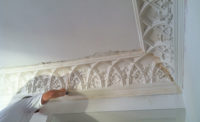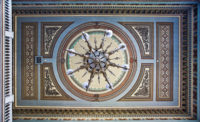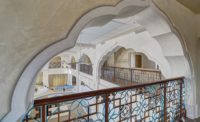A Tale of Plaster Toiling: Wood Lath and Plaster Ceilings

The trials and tribulations of wood lath and plaster ceilings.

The trials and tribulations of wood lath and plaster ceilings.

The trials and tribulations of wood lath and plaster ceilings.

The trials and tribulations of wood lath and plaster ceilings.

The trials and tribulations of wood lath and plaster ceilings.

The trials and tribulations of wood lath and plaster ceilings.






On a quiet, hot and seemingly uneventful weekday afternoon in June, 2016, a musical ensemble was rehearsing in the sanctuary of St. Ann & the Holy Trinity Episcopal Church in Brooklyn, New York. As the strains of the music reverberated through the spacious confines, a spherical cast plaster ornament six inches in diameter suddenly fell about 60 feet to the floor and landed in a startling, dust-ridden crash.
Fortunately, no one was hurt. Nonetheless, Father John Denaro, an Episcopal priest for 25 years and rector (pastor) of St. Ann & the Holy Trinity, took the incident as a signal for action. “While I didn’t quite see this as a crisis, it was certainly a wake-up call. There is so much plaster in this building, it was clear to me that the time had come to address it.”
St. Ann & Holy Trinity Church, a National Historic Landmark building, was erected between 1844 and 1847 by paper manufacturer Edgar Barlow who wanted a magnificent edifice for the City of Brooklyn. The church is located on the highest point in Brooklyn Heights, which was a rather sparsely settled area at that time but is now a very prominent neighborhood at a crossroads of a subway and across from Brooklyn City Hall.
Designed by architect Minard LaFever, the church features the first complete set of Bolton stained glass windows, created by the renowned William Jay Bolton and his brother John. A total of 55 stained glass windows were installed of which 54 remain.
Mega Church
Hundreds of cast plaster ornaments embellish the church’s nave and sanctuary, which feature an intricate fan vaulted plaster on wood lath ceiling, 63 feet high and comprising some 30,000 square feet of plaster surface.
A wood lath and plaster ceiling is an ingenious mechanical system designed to suspend plaster from a wood lath substrate. It involves mixing water, sand, lime and usually horsehair into a porridge-like goo, using a trowel to press the mixture up against strips of wood lath nailed to joists separated by 3/8-inch gaps, and forcing the plaster through the gaps so that it slumps over onto back of the wood lath to form keys and lugs, which when cured act as hooks to hold the ceiling in place.
The strips of wood lath are soaked in water before being nailed to the joists for a couple of reasons. First, the lath is pre-wet so that it doesn’t suck moisture from the plaster and prevent the important chemical reaction that must take place when the plaster cures. Second, when the wood lath dries, it shrinks away from the plaster, creating a gap that gives the assembly the flexibility it needs. As a result, a wood lath and plaster ceiling is designed to function as a suspended system—not an adhered system—held up by the keys and lugs formed by the plasterer.
Plaster Deterioration
The major cause of the demise of a wood lath and plaster ceiling is ongoing systemic deterioration. The main culprit is moisture from humidity, which moves through the plaster dissolving and mobilizing salts. The formation of the salts causes expansion which breaks down the plaster. One can tell this is happening by observing the effervescent salt deposits on the warm surface of a plaster ceiling. Usually, this can be best seen in the attic where many observers fear to tread.
Eventually, the plaster matrix becomes friable (powdery and weak), and the plaster keys and lugs that hold the ceiling suspended in place are either broken or rendered so weak that they can barely do their job. This deterioration takes place over many decades and is exacerbated by wide fluctuations in temperature, by building micro-movements and vibrations which cause the plaster keys and lugs to abrade, and by disturbance from the installation of various mechanical systems.
As a matter of pure fact, from the day that a wood lath and plaster ceiling is installed, it begins to experience this process of slow, unrelenting deterioration.
Immediately after the plaster ornament crashed to the floor at St. Ann & Holy Trinity, Father John summoned Lisa Easton of Easton Architects LLP, the church’s go-to architect. In turn, Ms. Easton contacted Ray Tiedemann to conduct an evaluation of the cast plaster ornament and the wood lath and plaster ceiling. Tiedemann is president of John Tiedemann Inc. and sister company, Historic Plaster Conservation Services USA.
Using JTI’s telescopic lift to avoid the need for scaffolding, the HPCS team sound-tested hundreds of plaster ornament throughout the building. Sound testing involves tapping a rubber mallet against the plaster ornament. About 150 pieces were found to be insecure or unstable. These were removed, repainted and secured back into place using a conservation method called pinning.
While waiting for a significant amount of pigeon droppings to be removed from the attic, a sound-testing exercise was conducted on the surface side of the plaster ceiling in an effort to detect any areas of imminent collapse.
The initial sounding results seemed promising. “From the underside, much of the ceiling sounded okay,” Lisa Easton reports. “It appeared to be structurally stable with a few weak spots here and there but we really didn’t see much cause for concern.”
As Ray Tiedemann points out, while sounding is a very useful technique for assessing the stability of cast plaster ornament, it is generally unreliable and misleading when determining the structural integrity of a wood lath and plaster ceiling. One must get to the back side of the ceiling to truly understand its condition.
The contemporary method of plaster assessment was developed by HPCS, which has long-established expertise in evaluating ceiling plaster. HPCS inspects and tests the plaster using a scientifically verifiable and repeatable method. It involves testing the plaster keys and lugs in a variety of samples areas that constitute a good representation of the ceiling as a whole. In the end, HPCS is able to establish a numerical value of today’s condition of the plaster relative to its as-built condition.
Based on considerable experience, HPCS has determined that if a plaster ceiling has less than 70 percent of its original structural integrity (more than 30 percent of key & lugs missing or broken), there is a major safety concern and treatment should be imminent.
With the pigeon droppings removed, the HPCS technical team went into the attic to assess the plaster. HPCS inspected and tested the keys and lugs in 10 different ceiling locations. The results were like night and day when compared to the sounding.
“Every area had a lot of broken keys and the plaster was in terrible shape,” Tiedemann reports. “It would just fall apart in your fingertips. By extrapolating the results, we estimated that the ceiling had lost about 50 percent of its original structural integrity. It was one of the worst cases of plaster deterioration we’ve ever come across. We were amazed that the ceiling hadn’t yet collapsed.”
This was not good news for Father John and the leadership of the church. The sounding exercise had provided a glimmer of hope that the ceiling might be in relatively good shape, but the report from HPCS indicated a serious safety issue with accompanying financial implications. As any responsible steward of such an important building would do, Father John sought a second opinion by asking Lisa Easton and engineers from Robert Silman Associates and Plan B Engineering LLC to conduct their own examination of the back side of the plaster.
“We walked the entire length of the nave and took a very good look,” says Easton. “By the time we were through, it was clear that the ceiling had very little structural integrity left. We estimated that only 25 percent of the ceiling was still intact. It was clearly not salvageable without serious intervention.”
All of this may beg the question: what’s so great about a plaster on wood lath ceiling anyway? Why not just tear it down and replace with drywall?
Due to its density, plaster on wood lath is much more durable than drywall and the surface plaster is more resistant to damage from water. In many instances, it carries valuable decoration of historic importance. You can round corners with it, which you cannot do with drywall. And plaster on wood lath provides infinitely superior acoustics, which is particularly important in a church or concert hall. The simple fact is plaster on wood lath ceilings are superior.
Plaster Consolidation
One type of intervention that would salvage the ceiling at St. Ann & Holy Trinity Church is a treatment method called plaster consolidation, developed by HPCS in the early 1980s and dramatically improved upon over the years. Plaster consolidation is a systemic approach to treatment in that it addresses the entire ceiling system, not just isolated areas of the most distressed plaster. The method involves applying various dilutions of non-toxic acrylic resins to the back side of the ceiling. The resins are specially formulated to optimize penetration into the plaster, are inherently flexible and are intended to achieve two major objectives:
- To significantly strengthen the plaster matrix; and
- To bond the plaster to the wood lath and convert the fragile suspended ceiling system into a strong, unified and durable adhered system.
As Father John readily acknowledges, the biggest challenge he faced was finding the funds to pay for the consolidation treatment program. He appealed to his parish community and his bishop who refers to the historic building as the “Mother Church” of the Episcopal Diocese of Long Island.
“We are very grateful for the support and sound advice of the Bishop and his team and for the commitment of church members to raise a lot of money,” says a relieved Father John. “This building means a great deal not only to the Diocese and the congregation but to neighbors and folks far and wide.”
Ray Tiedemann’s team completed the consolidation of the plaster ceiling at St. Ann & the Holy Trinity in twelve weeks. One of the interesting ironies of the HPCS plaster treatment method is that the worse the condition of the plaster, the better the treatment works. This is because badly deteriorated plaster is more porous and receptive to the application of acrylic resins.
The HPCS plaster consolidation work is guaranteed for 25 years but can be expected to last much longer than that.
It is not a stretch to think if that plaster ornament did not come crashing to the floor on that quiet, hot summer afternoon in Brooklyn, St. Ann & the Holy Trinity Church could very well have experienced a calamitous ceiling collapse. The good news is Father John Denaro will be presiding over the 2017 Easter Sunday services in the sanctuary. Call it divine intervention.
Looking for a reprint of this article?
From high-res PDFs to custom plaques, order your copy today!












